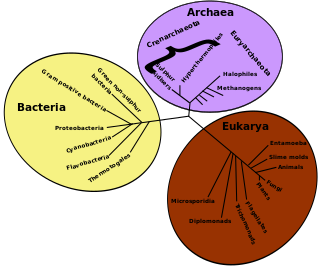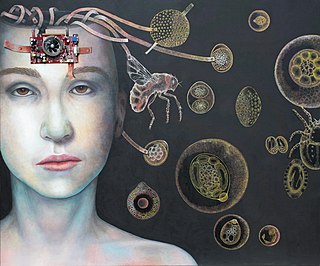
Parasitism is a close relationship between species, where one organism, the parasite, lives on or inside another organism, the host, causing it some harm, and is adapted structurally to this way of life. The entomologist E. O. Wilson characterised parasites as "predators that eat prey in units of less than one". Parasites include single-celled protozoans such as the agents of malaria, sleeping sickness, and amoebic dysentery; animals such as hookworms, lice, mosquitoes, and vampire bats; fungi such as honey fungus and the agents of ringworm; and plants such as mistletoe, dodder, and the broomrapes.

Evolutionary ecology lies at the intersection of ecology and evolutionary biology. It approaches the study of ecology in a way that explicitly considers the evolutionary histories of species and the interactions between them. Conversely, it can be seen as an approach to the study of evolution that incorporates an understanding of the interactions between the species under consideration. The main subfields of evolutionary ecology are life history evolution, sociobiology, the evolution of interspecific interactions and the evolution of biodiversity and of ecological communities.

Eucestoda, commonly referred to as tapeworms, is the larger of the two subclasses of flatworms in the class Cestoda. Larvae have six posterior hooks on the scolex (head), in contrast to the ten-hooked Cestodaria. All tapeworms are endoparasites of vertebrates, living in the digestive tract or related ducts. Examples are the pork tapeworm with a human definitive host, and pigs as the secondary host, and Moniezia expansa, the definitive hosts of which are ruminants.
Eric Rodger Pianka was an American herpetologist and evolutionary ecologist.

The pigeye shark or Java shark is an uncommon species of requiem shark, in the family Carcharhinidae, found in the warm coastal waters of the eastern Atlantic and western Indo-Pacific. It prefers shallow, murky environments with soft bottoms, and tends to roam within a fairly localised area. With its bulky grey body, small eyes, and short, blunt snout, the pigeye shark looks almost identical to the better-known bull shark. The two species differ in vertebral count, the relative sizes of the dorsal fins, and other subtle traits. This shark typically reaches lengths of 1.9–2.5 m (6.2–8.2 ft).

Cestoda is a class of parasitic worms in the flatworm phylum (Platyhelminthes). Most of the species—and the best-known—are those in the subclass Eucestoda; they are ribbon-like worms as adults, known as tapeworms. Their bodies consist of many similar units known as proglottids—essentially packages of eggs which are regularly shed into the environment to infect other organisms. Species of the other subclass, Cestodaria, are mainly fish infecting parasites.
Lecanicephaloidea is an order of tapeworms of the subclass Cestoda. Species in the order consist of intestinal parasites of elasmobranch fishes.
Joy K. Ward is a leading evolutionary biologist studying the impact of the environment on plants and ecosystems. She began a new role as the dean of the College of Arts & Sciences at Case Western Reserve University on July 1, 2020 - leaving behind her professorship at the University of Kansas. Her research on plant life has gained her notoriety in many scientific research fields. Aside from her work in the lab, she is also a strong advocate for advancing underrepresented communities' scientific learning and careers. As part of her deanship at the University of Kansas, Ward was an important factor in increasing the number of underrepresented individuals who held faculty positions in STEM subjects. Notably, as a result of her research efforts, she was awarded the Presidential Early Career Award for Scientists and Engineers by U.S. President Barack Obama.
Acanthobothrium bullardi is a species of parasitic onchobothriid tapeworm first found in the whiptail stingray, Dasyatis brevis, in the Gulf of California. This species of parasitic tapeworm was originally discovered alongside four other varieties of tapeworms in the Gulf of California during a survey of the area that was done in the years 1993 as well as 1996. Information on this discovery can be found in greater detail in the article written by Sohini Ghoshroy and J.N. Caira titled "Four New Species of Acanthobothrium from the Whiptail Stingray Dasyatis Brevis in the Gulf of California, Mexico". This article claims itself as the first document with record on these tapeworms in California. Although this particular variety has only been discovered on the bodies of whiptail stingray, other Acanthobothrium species have been found on the bodies of many more animals including sharks. This is described in the article written by Caroline Fyler titled "Systematics, biogeography and character evolution in the tapeworm genus Acanthobothrium van Beneden, 1850 ".
Diphyllidea is a monotypic order of Cestoda (tapeworms). Members of this order are gut parasites of elasmobranch fishes including rays and sharks. Disphyllidea infect their host’s spiral intestine. Scolex is the type of tapeworm associated with Disphyllidea, which have a hook-like structure that helps attach to their host’s gut.

Meghan Anne Duffy is an American biologist and the Susan S. Kilham Collegiate Professor of Ecology and Evolutionary Biology at the University of Michigan. She focuses on the causes and consequences of parasitism in natural populations of lake populations. In 2019, she created a task force to examine factors that influence the mental health and well-being of graduate students at the University of Michigan.
Tetragonoporus is a genus of cestodes in the order Pseudophyllidea. It is a monotypic genus, and the only species is Tetragonoporus calyptocephalus, previously known as Polygonoporus giganticus. This tapeworm is a gut parasite of whales.

Parasites appear frequently in biology-inspired fiction from ancient times onwards, with a flowering in the nineteenth century. These include intentionally disgusting alien monsters in science fiction films, often with analogues in nature. Authors and scriptwriters have, to some extent, exploited parasite biology: lifestyles including parasitoid, behaviour-altering parasite, brood parasite, parasitic castrator, and many forms of vampire are found in books and films. Some fictional parasites, like Count Dracula and Alien's Xenomorphs, have become well known in their own right.
Anna J. Phillips is an American Research Zoologist and curator of Clitellata and Cestoda at the National Museum of Natural History's Department of Invertebrate Zoology. As a parasitologist her research focuses on leeches and tapeworms, by studying their diversity, relationships, and host associations. She has traveled all over the world with her fieldwork to study the diversity of these invertebrates on a long range.
Anjali Goswami is a Resesarch Leader and Dean of the Graduate Centre at the Natural History Museum. She is an Honorary Professor of Paleobiology at University College London (UCL) in the Department of Genetics, Evolution, and Environment. She was elected President of the Linnean Society of London, in 2022 and is the first person of colour elected to this role since its founding in 1788. She was elected Fellow of the Royal Society in 2024. Goswami's expertise is in vertebrate evolution and development, particularly using high-resolution 3D images of specimens to quantify and reconstruct the evolution of biodiversity and understand how development, ecology and large-scale environmental effects have shaped animal evolution through deep time.

Daniel I. Bolnick is an American evolutionary biologist. He is a full professor at the University of Connecticut. He was editor-in-chief of the journal The American Naturalist from 1998-2003, and will be President of The American Society of Naturalists in 2025.
Kayla C. King is Professor of Evolutionary Ecology at University of Oxford, specialising in how interactions between hosts and parasites show evolutionary change.
Aimée Classen is an American ecologist who studies the impact of global changes on a diverse array of terrestrial ecosystems. Her work is notable for its span across ecological scales and concepts, and the diversity of terrestrial ecosystems that it encompasses, including forests, meadows, bogs, and tropics in temperate and boreal climates.
Acanthobothrium zimmeri is a species of tapeworm named after the author Carl Zimmer. A. zimmeri was first described in 2009 based on specimens collected from the Arafura Sea in Australia's Northern Territory. It parasitizes a species of stingray in the genus Himantura. It has also been found to parasite Urogymnus acanthobothrium.
Robin Lee Chazdon is an American tropical ecologist. She is a professor emeritus of ecology and evolutionary biology in the College of Liberal Arts and Sciences at the University of Connecticut.






